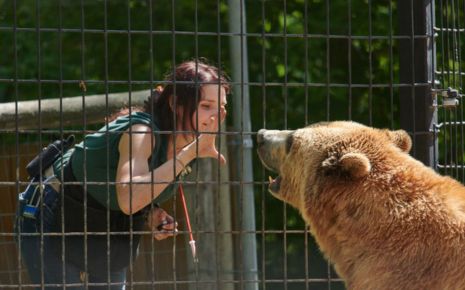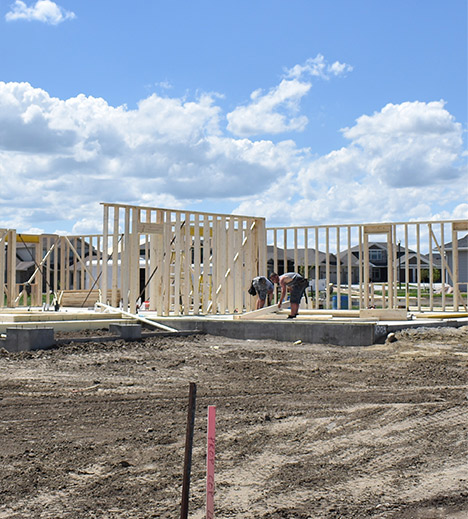
Dakota Zookeepers Make Their Mark Locally and in Conservation Efforts Worldwide
March 4, 2025
Even on the coldest winter days, there’s still poop to be scooped at the Dakota Zoo, and the keepers who work there are happy to do it. Shoveling and sweeping give the animals a more comfortable living environment while creating a pleasant experience for guests.
“Every interaction you have with an animal, you are communicating with them,” says Shannon Dickson, Senior Zookeeper at the Dakota Zoo. “You are learning from them. And that allows you to have a good relationship with the animal.”

Dickson is originally from Topeka, Kansas, but she has found a home in Bismarck-Mandan. Her role allows her to educate the public about conservation, both in North Dakota and across the world. Keep reading to see how she Makes Her Mark and why the Dakota Zoo is such an asset to the community.
Dickson Found Friendship Through the Bismarck-Mandan Animal Community
When Dickson moved to Bismarck-Mandan in 2018 for a job at the Dakota Zoo, she was stepping into a new chapter—not just in her career, but in finding a place to call home.
Having previously interned at the Topeka and Omaha zoos and spent time in Cameroon at a primate rehab and release center, she was no stranger to adapting to new environments. While Bismarck-Mandan’s size felt familiar, the North Dakota winters took some getting used to.
But what truly made her feel at home? The access to nature and the welcoming community.
“One thing I love is how easy it is to get out into nature in Bismarck,” says Dickson. “There’s a lot of nature and the short grass prairie is so beautiful!”

As an only child, she had always learned to make friends wherever she went, and that skill helped her settle into Mandan. With a team of 15 passionate coworkers at the Dakota Zoo and connections with fellow animal lovers in the area, she found both a career and a community. Now entering her 30s, she knows she’s exactly where she’s meant to be.
Bismarck-Mandan isn’t just a place to work—it’s a place to belong.
The Dakota Zoo Brings Visitors to Other Worlds
Dickson says she learned to appreciate the habitat of Bismarck-Mandan by living in it, but few people have the luxury of moving around the world and discovering different climates. To solve this, the Dakota Zoo allows visitors to experience different ecosystems and the animals that live in them. From the mountains of Mongolia to the rainforests of Africa, guests can learn more about different regions.
“We all live on the same planet and need to tie the public to the world around them so they can care about it,” says Dickson. “Our message is the only way to keep these animals around is you.”
Along with providing educational experiences, the Dakota Zoo funds conservation efforts. It allocates five percent of visitor spending to conservation, supporting programs that protect animals across the world and support rehabilitation and breeding programs. A visitor who spends an afternoon at the zoo can have a global wildlife impact.
Zookeepers also travel to do conservation work. In recent years, employees have studied black-footed ferrets in the Conata Basin and worked with African penguins in South Africa. Dickson even returned to Cameroon in 2023 to continue her work with primates.

Dakota Zookeepers Provide Exceptional Care in the Cold
Most animals at the Dakota Zoo are built for cold weather. Snow leopards thrive in Bismarck’s climate, and Bactrian camels are well-adapted to freezing conditions. But some animals need extra care in the winter. To keep them comfortable, the zoo invests in humidifiers to combat dry air and provides heated buildings where animals can live comfortably. Primate species, for example, have an indoor habitat designed to mimic their tropical homes, complete with branches for climbing.
Just as the Dakota Zoo adapts to keep its animals comfortable, the people of Bismarck-Mandan embrace winter by making the most of the season. Instead of hibernating, the community comes alive with outdoor activities like skiing, snowshoeing, and ice skating. Events like the Bismarck-Mandan Santa Run turn the cold into a celebration, proving that winter isn’t just something to endure—it’s something to enjoy.
“We want to show people that this is a good place, a comfortable place, and a place with a high level of animal welfare,” says Dickson.
The Dakota Zoo is accredited by both the Association of Zoos and Aquariums (AZA) and the Zoological Association of America (ZAA), making it one of the few institutions to hold dual accreditation.

Plan Your Visit to the Dakota Zoo
During the winter months, the Dakota Zoo is open on Friday, Saturday, and Sunday in the afternoons. In late April, it opens to the public seven days a week throughout the day. Residents can book birthday parties, behind-the-scenes tours, and community outings throughout the year.
When you visit, Dickson recommends listening to keeper talks throughout the zoo. In particular, keep an eye out for Elmer. He’s a North American porcupine that was hand-raised by zookeepers when his mom couldn’t care for him. This animal ambassador teaches hunters to protect their dogs by offering training tips so they stay away from porcupines. This keeps both the dogs and local wildlife safe.
Share How You Make Your Mark
People from all walks of life contribute to Bismarck-Mandan's ecosystem. We’ve seen people Make Their Mark by baking cookies, growing pumpkins, and putting together impressive holiday displays.
Tell us how you Make Your Mark on the area, whether you are part of a local community or run a small business. We’d love to tell your story and continue painting a beautiful picture of this region.
If you’re considering relocating to the area, learn more about life in Bismarck-Mandan and how you can thrive here.



